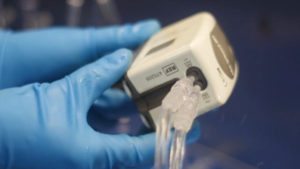
Two Reasons Following IFUs is a Necessity
Reusable medical devices can present a host of opportunities for hospital acquired infections (HAIs) or surgical site infections (SSIs). One critical area in which the risk for HAIs and SSIs must be reduced involves following manufacturers’ instructions for use (IFU) during the decontamination and sterilization processes.
The complexity of instruments that central sterile processing departments are charged with cleaning, is changing and evolving. From laparoscopic instruments with small hinges and lumens to rigid and flexible scopes with delicate channels, these instruments require specific steps to ensure that they are properly cleaned and sterilized. Without doing so, the risk to patient and staff safety increases exponentially.
 IFUs are “written recommendations provided by the manufacturer that provide instructions for operation and safe and effective use of its device. …The device manufacturer is responsible for ensuring that the device can be effectively cleaned and sterilized with the means and methods available in health care facilities. Sterilization validation of a device requires microbiological, engineering, toxicological, and sometimes clinical evaluations of the device, which are beyond the abilities of most health care facilities. To ensure patient safety, a reusable device needs to be capable of being thoroughly cleaned and sterilized. The device labeling describes specific methods of cleaning and sterilization that have been validated by the manufacturer.”[1]
IFUs are “written recommendations provided by the manufacturer that provide instructions for operation and safe and effective use of its device. …The device manufacturer is responsible for ensuring that the device can be effectively cleaned and sterilized with the means and methods available in health care facilities. Sterilization validation of a device requires microbiological, engineering, toxicological, and sometimes clinical evaluations of the device, which are beyond the abilities of most health care facilities. To ensure patient safety, a reusable device needs to be capable of being thoroughly cleaned and sterilized. The device labeling describes specific methods of cleaning and sterilization that have been validated by the manufacturer.”[1]
Throughout the decontamination and sterilization process, ANSI/AAMI ST79: 2017 Comprehensive guide to steam sterilization and sterility assurance in health care facilities, requires that departments ensure effective decontamination and sterilization by following the device manufacturer’s written IFU. To do so, IFUs should be easily accessible, reviewable, and followed. If no IFU exists for a device, instrument, equipment, or solution, the manufacturer should be contacted and a documented method of cleaning should be provided.
 IFUs address several areas of concern. Many instruments or devices have numerous parts that must be disassembled for proper reprocessing. Understanding how those intricate parts work, the design elements, and possibly overlooked areas for cleaning, are essential to ensuring that a device is sterilized. Cleaning solution IFUs are another area that need to be taken into consideration. Proper dilution, concentration, temperature and contact time are vital for ensuring proper decontamination and sterilization. Additionally, some instruments and devices cannot be treated with specific solutions. Following manufacturers’ IFU will help prevent unnecessary damage the instrument. IFUs for reprocessing equipment are equally important. Without proper knowledge of the tools used to reprocess the instruments, effective reprocessing cannot be achieved.
IFUs address several areas of concern. Many instruments or devices have numerous parts that must be disassembled for proper reprocessing. Understanding how those intricate parts work, the design elements, and possibly overlooked areas for cleaning, are essential to ensuring that a device is sterilized. Cleaning solution IFUs are another area that need to be taken into consideration. Proper dilution, concentration, temperature and contact time are vital for ensuring proper decontamination and sterilization. Additionally, some instruments and devices cannot be treated with specific solutions. Following manufacturers’ IFU will help prevent unnecessary damage the instrument. IFUs for reprocessing equipment are equally important. Without proper knowledge of the tools used to reprocess the instruments, effective reprocessing cannot be achieved.
While instrument damage and inventory protection is important, there are only two reasons why manufacturers’ IFU must be made available and followed:
- Patients: “IFU compliance is a must because we impact patients’ lives when the instruments used are contaminated. Patients come into the surgical suite with a medical problem that can be made better with surgery; the instruments used on that case must be processed following the IFU all in the name of patient safety.”[2]
- Staff: Your staff is your most valuable asset. Simply put, without central sterile processing staff, reusable medical devices would not get reprocessed. The risk of injury from equipment and instruments as well as exposure to harmful chemicals can be reduced by following IFUs. Departments cannot afford to lose their most valuable assets to often avoidable injuries.
Many tools exist for helping central sterile processing departments to ensure IFUs are followed. From digital databases that can be accessed through a computer at a workstation, to available hard copies of IFUs, departments must make sure IFUs are accessible to all staff. Training and in-servicing help to ensure that IFUs are followed, patient safety is not compromised, and that staff are able to safely perform their tasks.
[1] ANSI/AAMI ST79:2017, Definitions and Abbreviations
[2] https://www.infectioncontroltoday.com/view/importance-following-manufacturers-ifus



